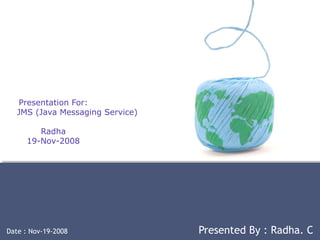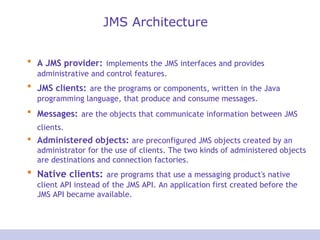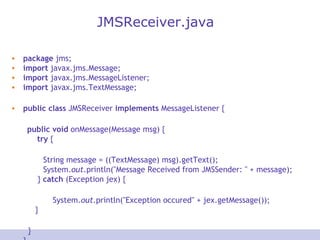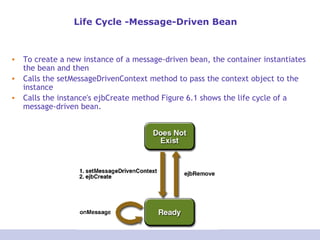test
- 1. Presentation For: JMS (Java Messaging Service) Radha 19-Nov-2008 Date : Nov-19-2008 Presented By : Radha. C
- 2. What is Messaging Messaging * It enables distributed communication that is loosely coupled. ŌĆó Sender and receiver need not know anything about each other (except the destination and message format) * Messaging is a peer to peer facility. ŌĆó A messaging client can send mail to and receive messages from any other client. ŌĆó messaging agent
- 3. JMS API ŌĆó To create, send, receive, and read messages. ŌĆó Messages are ŌĆó Asynchronous: ŌĆó Reliable: Circumstances When We can Use JMS : ŌĆó The provider wants the components not to depend on information about other components' interfaces, so that components can be easily replaced. ŌĆó The provider wants the application to run whether or not all components are up and running simultaneously. ŌĆó The application business model allows a component to send information to another and to continue to operate without receiving an immediate response
- 4. JMS Architecture ’é¦ A JMS provider: implements the JMS interfaces and provides administrative and control features. ’é¦ JMS clients: are the programs or components, written in the Java programming language, that produce and consume messages. ’é¦ Messages: are the objects that communicate information between JMS clients. ’é¦ Administered objects: are preconfigured JMS objects created by an administrator for the use of clients. The two kinds of administered objects are destinations and connection factories. ’é¦ Native clients: are programs that use a messaging product's native client API instead of the JMS API. An application first created before the JMS API became available.
- 6. Messaging Domains ŌĆó Point-to-Point ŌĆó Concept of message queues, senders and receivers. ŌĆó Queues retain all messages sent to them until the messages are consumed or until the messages expire. ŌĆó Characteristic ŌĆó Each message has only one consumer. ŌĆó A sender and a receiver of a message have no timing dependencies. ŌĆó The receiver acknowledges the successful processing of a message. ŌĆó When To Use?
- 8. Messaging Domains ŌĆó Publish/Subscribe ŌĆó Concept of topic. ŌĆó Publishers and subscribers are generally anonymous may dynamically publish or subscribe to the content hierarchy. ŌĆó Topics retain messages only as long as it takes to distribute them to current subscribers. ŌĆó Pub/sub messaging has the following characteristics. ŌĆó Each message may have multiple consumers. ŌĆó Publishers and subscribers have a timing dependency. ŌĆó durable subscriptions ŌĆó When to use?
- 9. Messaging Domains Publish/ Subscribe Messaging
- 10. Message Consumption ŌĆó Messages can be consumed in either of two ways: ŌĆó Synchronously. A subscriber or a receiver explicitly fetches the message from the destination by calling the receive method. ŌĆó Asynchronously. A client can register a message listener with a consumer. A message listener is similar to an event listener.
- 11. Administered Objects ŌĆó Two parts of a JMS application-- destinations and connection factories--are best maintained administratively rather than programmatically. ŌĆó JMS clients access these objects through interfaces.
- 12. Administered Objects ŌĆó Connection Factories A connection factory is the object a client uses to create a connection with a provider. A pair of connection factories come preconfigured with the J2EE SDK and are accessible as soon as you start the service. We can use the default connection factory objects, to create connections. At the beginning of a JMS client program, perform a JNDI API lookup of the connection factory. Following code fragment obtains an InitialContext object and look up the QueueConnectionFactory and the TopicConnectionFactory by name: Context ctx = new InitialContext(); QueueConnectionFactory queueConnectionFactory = (QueueConnectionFactory) ctx.lookup("QueueConnectionFactory"); TopicConnectionFactory topicConnectionFactory = (TopicConnectionFactory) ctx.lookup("TopicConnectionFactory"); j2eeadmin -addJmsFactory jms/EarthQCF queue
- 13. Destinations ŌĆó A destination is the object a client uses to specify the target of messages it produces and the source of messages it consumes. In the PTP messaging domain, destinations are called queues, and you use the following J2EE SDK command to create them: ŌĆó j2eeadmin -addJmsDestination queue_name queue ŌĆó In the pub/sub messaging domain, destinations are called topics, and you use the following J2EE SDK command to create them: ŌĆó j2eeadmin -addJmsDestination topic_name topic ŌĆó A JMS application may use multiple queues and/or topics. ŌĆó In addition to looking up a connection factory, you usually look up a destination. Example: code performs a JNDI API lookup of the previously created topic ŌĆ£MyTopicŌĆØ and assigns it to a Topic object: Topic myTopic = (Topic) ctx.lookup("MyTopic"); Code to look up a queue named ŌĆ£MyQueueŌĆØ and assigns it to a Queue object: Queue myQueue = (Queue) ctx.lookup("MyQueue");
- 14. Connections ŌĆó A connection encapsulates a virtual connection with a JMS provider. ŌĆó For example, once we have a QueueConnectionFactory or a TopicConnectionFactory object, we can use it to create a connection: QueueConnection queueConnection = queueConnectionFactory.createQueueConnection(); TopicConnection topicConnection = topicConnectionFactory.createTopicConnection(); On application completion, we need to close any connections that we have created. queueConnection.close(); topicConnection.close(); Before our application can consume messages, we must call the connection's start method.
- 15. Sessions ŌĆó A session is a single-threaded context for producing and consuming messages. ŌĆó Are use to create message producers, message consumers, and messages. ŌĆó Provides a transactional context. ŌĆó Come in two forms, implementing either the QueueSession or the TopicSession interface. Eg. Connection object ŌĆó Example, TopicConnection object created, can be use to create a TopicSession: TopicSession topicSession = topicConnection.createTopicSession(false,Session.AUTO_ACKNOWLEDGE); Similarly, can use a QueueConnection object to create a QueueSession: QueueSession queueSession = queueConnection.createQueueSession(true, 0);
- 16. Message Producers ŌĆó A message producer is an object created by a session and is used to send messages to a destination. ŌĆó The PTP form of a message producer implements the QueueSender interface. ŌĆó The pub/sub form implements the TopicPublisher interface. eg. QueueSession to create a sender for the queue myQueue, and use a TopicSession to create a publisher for the topic myTopic: QueueSender queueSender = queueSession.createSender(myQueue); TopicPublisher topicPublisher = topicSession.createPublisher(myTopic); ŌĆó Once created a message producer, can use it to send messages. queueSender.send(message); With a TopicPublisher, use the publish method: topicPublisher.publish(message); If created an unidentified producer, use the overloaded send or publish method that specifies the destination as the first parameter.
- 17. Message Consumers ŌĆó Is an object created by a session and is used for receiving messages sent to a destination. The PTP form of message consumer implements the QueueReceiver interface. The pub/sub form implements the TopicSubscriber interface. QueueReceiver queueReceiver = queueSession.createReceiver(myQueue); TopicSubscriber topicSubscriber = topicSession.createSubscriber(myTopic); ŌĆó Once created a message consumer, it becomes active, and can use it to receive messages. ŌĆó Message delivery does not begin until we start the connection created earlier, by calling the start method. ŌĆó With either a QueueReceiver or a TopicSubscriber, use the receive method to consume a message synchronously. Can use this method at any time after calling start method: queueConnection.start(); Message m = queueReceiver.receive(); topicConnection.start(); Message m = topicSubscriber.receive(1000); // time out after a second To consume a message asynchronously use message Listener.
- 18. Message Listeners ŌĆó This is an object that acts as an asynchronous event handler for messages. ŌĆó onMessage method. ŌĆó setMessageListener method. MessageListener listener=new myListener(); consumer.setMessageListener(listener); ŌĆó After registering the message listener, call the start method on the QueueConnection or the TopicConnection to begin message delivery. ŌĆó A message listener is not specific to a particular destination type **. ŌĆó onMessage method should handle all exceptions. ŌĆó The session used to create the message consumer serializes the execution of all message listeners registered with the session. At any time, only one of the session's message listeners is running.
- 19. Message Selectors ŌĆó If messaging application needs to filter messages it receives, can use this JMS API. ŌĆó Message selector API assigns the task of message selection to JMS client reducing overhead of application. ŌĆó A message selector is a String that contains an expression. ŌĆó The createReceiver, createSubscriber, and createDurableSubscriber methods each have a form that allows you to specify a message selector as an argument when you create a message consumer. ŌĆó The message consumer then receives only messages whose headers and properties match the selector.
- 20. Messages ŌĆó The ultimate purpose of a JMS application is to produce and to consume messages that can then be used by other software applications. JMS messages have a basic format that is simple but highly flexible. ŌĆó A JMS message has three parts: ŌĆó A header. ŌĆó Properties (optional). ŌĆó A body (optional).
- 21. Message Headers ŌĆó A JMS message header contains a number of predefined fields. ŌĆó Each header field has associated setter and getter methods. Some header fields are intended to be set by a client, but many are set automatically by the send or the publish method, which overrides any client-set values. Header Field Set By JMSDestination send or publish method JMSDeliveryMode send or publish method JMSExpiration send or publish method JMSPriority send or publish method JMSMessageID send or publish method JMSTimestamp send or publish method JMSCorrelationID Client JMSReplyTo Client JMSType Client JMSRedelivered JMS provider
- 22. Message Properties ŌĆó Can create and set properties for messages if need values in addition to those provided by the header fields. ŌĆó Can use properties to provide compatibility with other messaging systems, or can use them to create message selectors For an example of setting a property to be used as a message selector. ŌĆó The JMS API provides some predefined property names that a provider may support. The use of either predefined properties or user-defined properties is optional.
- 23. Message Bodies ŌĆó The JMS API defines five message body formats called message types, which allow to send and to receive data in many different forms and provide compatibility with existing messaging formats. ŌĆó JMS API provides methods for creating messages of each type and for filling in their contents.
- 24. ŌĆó Eg. To create and send a TextMessage to a queue, TextMessage message = queueSession.createTextMessage(); message.setText(msg_text); // msg_text is a String queueSender.send(message); ŌĆó Eg. To receive a message sent from queue, Message m = queueReceiver.receive(); if (m instanceof TextMessage) { TextMessage message = (TextMessage) m; System.out.println("Reading message: " + message.getText()); } else { // Handle error }
- 25. Exception Handling ŌĆó The root class for exceptions thrown by JMS API methods is JMSException. ŌĆó Catching JMSException provides a generic way of handling all exceptions related to the JMS API. ŌĆó The JMSException class includes the following subclasses, which are described in the API documentation: ’é¦ IllegalStateException ’é¦ InvalidClientIDException ’é¦ InvalidDestinationException ’é¦ InvalidSelectorException ’é¦ JMSSecurityException ’é¦ MessageEOFException ’é¦ MessageFormatException ’é¦ MessageNotReadableException ’é¦ MessageNotWriteableException ’é¦ ResourceAllocationException ’é¦ TransactionInProgressException ’é¦ TransactionRolledBackException
- 26. JMSReceiver.java ŌĆó package jms; ŌĆó import javax.jms.Message; ŌĆó import javax.jms.MessageListener; ŌĆó import javax.jms.TextMessage; ŌĆó public class JMSReceiver implements MessageListener { public void onMessage(Message msg) { try { String message = ((TextMessage) msg).getText(); System.out.println("Message Received from JMSSender: " + message); } catch (Exception jex) { System.out.println("Exception occured" + jex.getMessage()); } }
- 27. JMSSender.java ŌĆó package jms; ŌĆó import javax.jms.JMSException; ŌĆó import javax.jms.Message; ŌĆó import javax.jms.Session; ŌĆó import javax.jms.TextMessage; ŌĆó import org.springframework.jms.core.JmsTemplate; ŌĆó import org.springframework.jms.core.MessageCreator; ŌĆó public class JMSSender { ŌĆó private JmsTemplate jmsTemplate; ŌĆó public void sendJms(UserTo obj) { ŌĆó jmsTemplate.send(makeMessageCreator(obj)); ŌĆó } ŌĆó public MessageCreator makeMessageCreator(UserTo obj) { ŌĆó final UserTo userTO = obj; ŌĆó return new MessageCreator() { ŌĆó public Message createMessage(Session session) throws JMSException { ŌĆó TextMessage message = null; ŌĆó try {
- 28. JMS API in a J2EE Application ŌĆó Since the J2EE1.3 , the JMS API has been an integral part of the platform ŌĆó J2EE components can use the JMS API to send messages that can be consumed asynchronously by a specialized Enterprise Java Bean ’é¦ message-driven bean ŌĆó acts as a listener for the JMS, processing messages asynchronously Enterprise Java Beans ŌĆó EJB is a server-side component that encapsulates the business logic of an application ŌĆó EJB simplifies the development of large, distributed applications ’é¦ EJB Container provides system-level services ŌĆó e.g. transaction management, authorization
- 29. JMS with EJB Example EJB Container automatically performs several setup tasks that standalone client has to do:-creating a msgconsumer instead, you associate the message-driven bean with a destination and connection factory at deployment time
- 30. Life Cycle -Message-Driven Bean ŌĆó To create a new instance of a message-driven bean, the container instantiates the bean and then ŌĆó Calls the setMessageDrivenContext method to pass the context object to the instance ŌĆó Calls the instance's ejbCreate method Figure 6.1 shows the life cycle of a message-driven bean.
- 31. Creating the J2EE Application ŌĆó Writing and compiling the components of this application involve ŌĆó Coding the application client ŌĆó Coding the message-driven bean ŌĆó Compiling the source files ŌĆó Starting the J2EE server and the Application Deployment Tool ŌĆó Creating a queue ŌĆó Creating the J2EE application ŌĆó Packaging the application client ŌĆó Packaging the message-driven bean ŌĆó Checking the JNDI API names ("JNDI names")
- 32. MDB Example public class MB implements MessageDrivenBean, MessageListener{ public void ejbCreate(){} public void ejbRemove(){} public void setMessageDrivenContext(MessageDrivenContext mdc){} pubic void onMessage(Message m){ //do computation on the incoming message try{ if (m instanceof TextMessage) System.out.println(ŌĆ£MBean: messageŌĆØ+m.getText()); }catch(JMSException exp){ ...} } }
Editor's Notes
- #18: Tip: Can use a QueueSession to create a receiver for the queue myQueue, and TopicSession to create a subscriber for the topic myTopic
- #19: Once message delivery begins, the message consumer automatically calls the message listener's onMessage method whenever a message is delivered. The onMessage method takes one argument of type Message, which the method can cast to any of the other message types. **The same listener can obtain messages from either a queue or a topic, depending on whether the listener is set by a QueueReceiver or a TopicSubscriber object.
- #22: -Every message has a unique identifier, represented in the header field JMSMessageID. -The value of another header field, JMSDestination, represents the queue or the topic to which the message is sent. -Other fields include a timestamp and a priority level.































